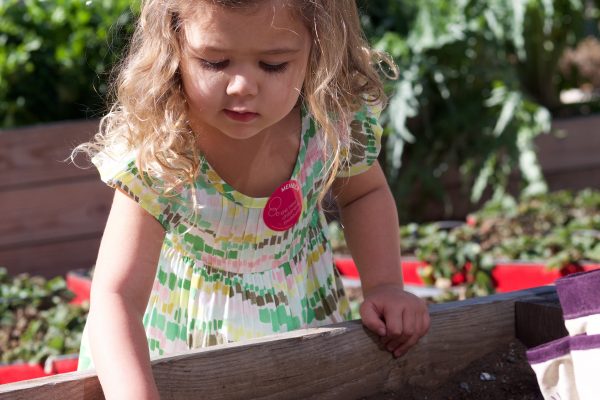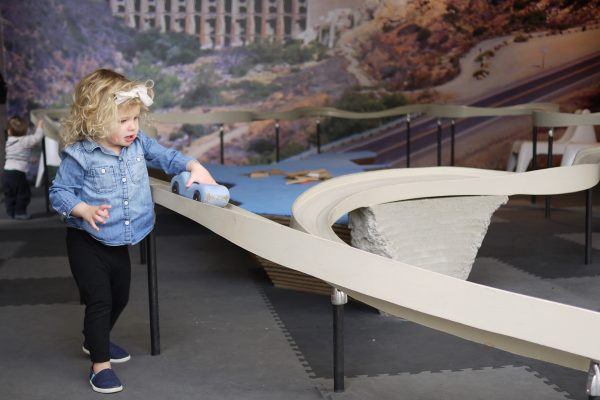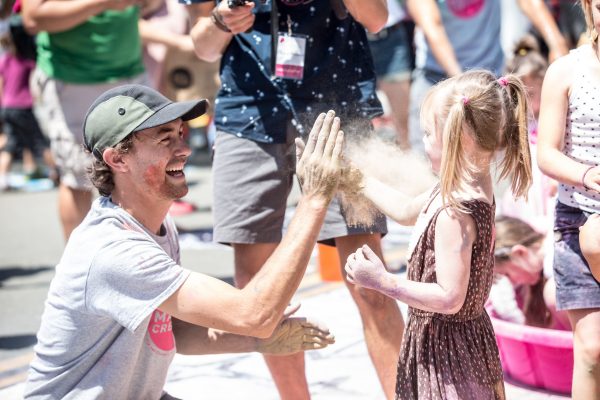do it yourself: homemade kites
Make a kite and watch it fly! Use wrapping paper, drinking straws and other items from home to put together a lightweight work of art and beginner kite that will soar through the sky on a windy day!
guidelines + materials
AGE: 6+ (with adult support)
TIME FRAME: 30 – 45 minutes
SUPPLIES:
- Cereal Box
- 12” x 12” or larger wrapping paper, newspaper or other lightweight paper
- 6 Paper or plastic straws
- Skein of yarn or spool of string
- Roll of 2” masking tape
- Roll of clear tape
- Pencil
- Marker or pen
- Ruler (12” or larger) or straight edge
- Scissors
- Plastic grocery bag
directions
1. Create the kite pattern. Open the cereal box at the seams and flatten it out completely. On one side of the box (cardboard side facing up) use the pencil and straight edge to draw a line down the center. Create a triangle at the top of the box by drawing two slanted lines out from the center line and a straight line across. Then draw longer lines slanting in to finish the large diamond shape. Using a marker, draw over the outline of the diamond shape. Then cut out a diamond kite pattern from the cardboard.
2. Cut out the kite. Take the wrapping paper (or other lightweight paper) and roll it out. Use the cardboard kite pattern, trace the diamond kite shape on top of the paper (pattern side down) and carefully cut it out. Tip: When tracing onto the paper, use small rocks or other items to hold the paper down if it is rolling up.
3. Frame the kite. Using six straws, create the kite frame on the inside of the paper. Lay and tape the straws down one at a time, beginning with the top horizontal line (bottom of the upper triangle). No straws should completely overlap, so you’ll need to trim them as you go. Tip: Masking tape can be used for the center straws, but clear tape is best for the outside straws as it can wrap around the other side unseen.
4. Make the kite line. Measure out 20 feet of string or yarn for the kite line. Take a small piece of unused cereal box cardboard (about the size of a palm) and cut triangles out of both ends of it (so it looks like a bow shape). Then tape one end of the yarn/string to the center and wrap most of the string (save one foot) around the cardboard. Take the tail of the string and tie it onto the center straw of the kite.
5. Add the kite tail. Make a tail for your kite! Measure out 3 feet of string or yarn for the kite tail. Tie one end onto the bottom of the kite frame. Add some extra flair to your kite by creating bows for your tail. Use a plastic grocery bag and cut 1″ x 4” strips and tie them onto the kite tail spaced out evenly.
6. Fly your kite! The best day to fly your kite is a windy one. When ready, take your kite outside to an open space, away from trees and power lines. If you are having trouble getting your kite in the air, have a friend or family member hold up the kite for you as you run with it. Let it go and watch it take to the sky!
Additional Learning Activities (Grades 2 – 6)
When the Wind Blows
Use your kite to learn more about wind speed. With your child, take your kite out and fly it over a period of several days. How is the air each day? Calm, breezy, strong? Record your findings on a calendar or in a journal. Which day was best for flying your kite?
Science and Kites
Kites have a long history and have been created in many cultures. Scientists throughout history have also used kites within their experiments. With your child, research people in history whose work with kites resulted in important discoveries and share your findings with your family.
Select a Story!
Reading is a wonderful vehicle for learning and for introducing new ideas to learners. Select engaging and age-appropriate books that feature kites and related stories to read to children before and/or after the kite-making activity.
Recommended Related Reading (Ages 3 – 8):
- Kite Day: A Bear and Mole Story by Will Hillenbrand
- In the Wind (In the Weather) by Elizabeth Spurr and illustrated by Manelle Oliphant
- Kite Flying by Grace Linn
- Casey’s Kite by Rick Miller and illustrated by Katie Risor
CA State Standards
CA Arts Standards for Visual Arts (Grades 1 – 3)
- Explore uses of materials and tools to create works of art or design.
- Brainstorm to generate multiple approaches to an art or design problem.
- Apply knowledge of available resources, tools and technologies to investigate personal ideas through the art-making process.
CA Arts Standards for Science (Grades 1 – 2)
- Grade 1 Earth Sciences – Students know how to use simple tools (e.g., thermometer, wind vane) to measure weather conditions and record changes from day to day and across the seasons.
- Grade 2 Physical Sciences – Students know the way to change how something is moving is by giving it a push or a pull. The size of the change is related to the strength, or the amount of force, of the push or pull.



